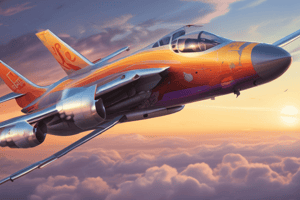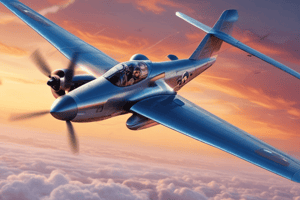Podcast
Questions and Answers
What is the primary force opposing motion in an aircraft?
What is the primary force opposing motion in an aircraft?
- Thrust
- Weight
- Drag (correct)
- Lift
Bernoulli's Principle states that air pressure increases as velocity increases.
Bernoulli's Principle states that air pressure increases as velocity increases.
False (B)
What is the main function of control surfaces in an aircraft?
What is the main function of control surfaces in an aircraft?
Control aircraft orientation and direction
The curved surface of an airfoil deflects air ______________, creating lift.
The curved surface of an airfoil deflects air ______________, creating lift.
What type of aircraft uses rotating wings to generate lift?
What type of aircraft uses rotating wings to generate lift?
The Four Forces of Flight are lift, weight, thrust, and gravity.
The Four Forces of Flight are lift, weight, thrust, and gravity.
What is the purpose of flaps on an aircraft?
What is the purpose of flaps on an aircraft?
Match the following aircraft components with their functions:
Match the following aircraft components with their functions:
Flashcards are hidden until you start studying
Study Notes
Aerodynamics
- Lift: upward force opposing weight, created by air flowing over curved surface of wing
- Drag: backward force opposing motion, created by air resistance
- Thrust: forward force propelling aircraft, generated by engines or propellers
- Bernoulli's Principle: air pressure decreases as velocity increases, explaining lift generation
- Angle of Attack: angle between wing and oncoming airflow, affecting lift and drag
Aircraft Design
- Fixed-Wing Aircraft: wing shape and angle provide lift, fuselage contains payload and crew
- Rotorcraft: rotating wings (rotors) generate lift, used in helicopters and gyrocopters
- Gliders: no engine, use gravity and aerodynamics to stay aloft
- Airframe: structural components, including fuselage, wings, and control surfaces
- Control Surfaces: ailerons, elevators, and rudder control aircraft orientation and direction
How Things Fly
- Four Forces of Flight: lift, weight, thrust, and drag interact to maintain stable flight
- Airfoil: curved surface deflecting air downward, creating lift and reducing drag
- Wing Camber: curved upper surface and flat lower surface enhance lift generation
- Flaps: movable surfaces on wing, increasing lift during takeoff and landing
- Air resistance: opposition to motion, affected by shape, size, and velocity of object
Aerodynamics
- Lift opposes weight and is created by air flowing over the curved surface of a wing, resulting in an upward force
- Drag opposes motion and is caused by air resistance, resulting in a backward force
- Thrust propels an aircraft forward and is generated by engines or propellers
- Bernoulli's Principle explains lift generation by stating that air pressure decreases as velocity increases
- Angle of attack affects lift and drag, with a higher angle resulting in increased lift but also increased drag
Aircraft Design
- Fixed-wing aircraft use a fixed wing shape and angle to provide lift, with the fuselage containing the payload and crew
- Rotorcraft use rotating wings (rotors) to generate lift, commonly used in helicopters and gyrocopters
- Gliders use gravity and aerodynamics to stay aloft, with no engine to provide thrust
- Airframe refers to the structural components of an aircraft, including the fuselage, wings, and control surfaces
- Control surfaces, such as ailerons, elevators, and the rudder, control an aircraft's orientation and direction
Principles of Flight
- The four forces of flight - lift, weight, thrust, and drag - interact to maintain stable flight
- An airfoil is a curved surface that deflects air downward, creating lift and reducing drag
- Wing camber, where the upper surface is curved and the lower surface is flat, enhances lift generation
- Flaps are movable surfaces on a wing that increase lift during takeoff and landing
- Air resistance is the opposition to motion, affected by an object's shape, size, and velocity
Studying That Suits You
Use AI to generate personalized quizzes and flashcards to suit your learning preferences.




